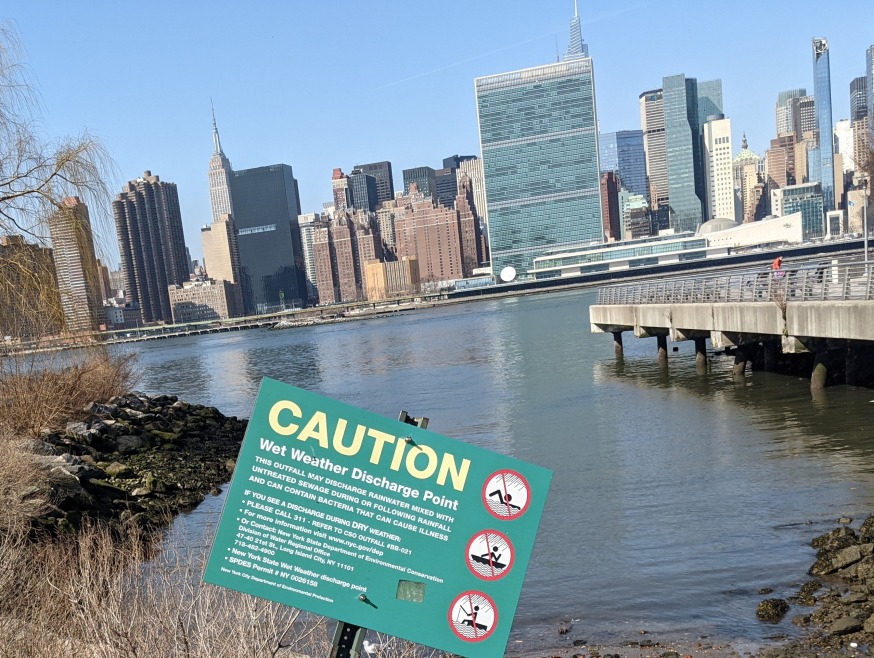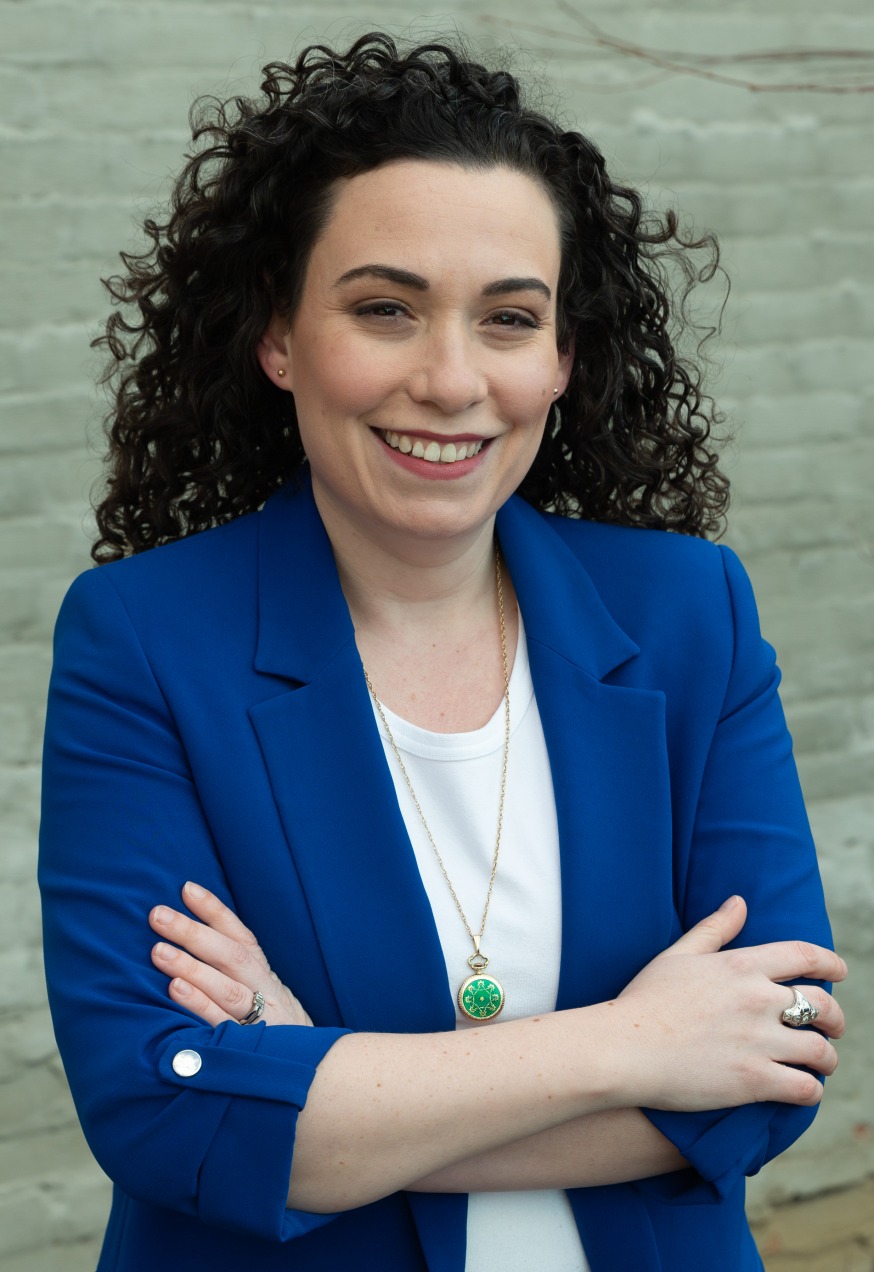
Wet weather discharge point sign taken in Long Island City (Photo: Julia Forman)
March 11, 2021 Op-Ed By: Julia Forman
It’s no secret that in parts of Long Island City, our neighbors can’t flush their toilet during heavy rainfall. That’s because of a sewage system that was designed for the smaller population living here more than half a century’s worth of development ago.
Why are we trying to bring in new residents when the old residents can’t flush their toilets in a thunderstorm? Why are we building luxury towers if we can’t even afford to provide basic, quality of life essentials to the people who live here now?
And while District 26 has plenty of transportation options, from subway lines to bus routes and an increasing number of bike lanes, the truth is that nearly all of those options are operating over their intended capacity.
It’s become popular to categorize anyone who opposes any proposed development as a NIMBY, so I want to make something clear. I want housing in my backyard. I want development in my backyard. I want anything that can help make life better and more affordable for the people who are already in our neighborhoods in my backyard. But none of that is possible without addressing the infrastructure currently on the brink of catastrophic failure in Western Queens’ 26th Council District.
Anybody who has spent a rush hour waiting at Queens Plaza, Queensboro Plaza, or Court Square (respectively ranked 107, 105, and 53 out of 472 for volume of passengers) knows their grim, tight-as-sardine nature at peak times. Who hasn’t stood on a crowded platform, with a pinch of nervousness about ending up on the tracks? Even before Covid-19, these conditions were untenable.
When luxury developers are touting our transportation system as a selling point, they aren’t selling the reality that my neighbors and I are living in. They’re selling a fantasy version of the system that our city’s and state’s leaders have been unwilling to maintain as the population of Western Queens booms.

Julia Forman (Photo: votejulia.com)
District 26 is also home to the second most crowded school district in Queens. While a recent luxury development effort offered to include three new schools, they would only have added capacity for children of the new residents, resolving none of the existing shortage.
This, like so many solutions proposed by developers, is simply treading water. It might keep your head above water for now, but you’d better hope for something better to come along.
It’s time to do more than hope.
When people move into our area for a nice new home, we want them to become a part of the community. That means we want them to be able to flush their toilets. We want them to be able to catch a train without body-surfing at Queensboro Plaza. And we want them to send their children to community schools where their children have a desk and a locker and aren’t fighting for the attention of an overburdened teacher. We want them to come out for Open Streets and Open Culture and we want them to spend their money at local businesses – because that’s what a community does.
As City Council member for District 26, I promise to work with city officials and prospective developers to ensure that our sanitation, transportation, and education needs are met before any more large-scale luxury development can be approved. I promise to make sure we have housing options available for all of our neighbors, regardless of their income. I promise to hold those seeking luxury development accountable and responsible for the quality of life of our whole community, and to bring Western Queens infrastructure that actually meets the needs of our neighbors.
I promise to fight for all of us.
Julia Forman is a city council candidate running to represent District 26, which covers Sunnyside, Woodside, Long Island City and a portion of Astoria
7 Comments

Did I miss the part of the column where Foreman actually proposed solutions to these “problems”. There was so much dinosaur thinking about how things used to be and NIMBYism, I could have. Face it: the towers along the water are the future of the neighborhood and they are better populated by people with money than not.
The luxury development you refer to that proposed three new schools was also proposing to take 45 acres out of the LIC storm water collection system. Separating storm water runoff from sanitary collection is the solution to this problem. The sanitary system in LIC actually has plenty of capacity. It’s when you flood it with rainwater that you get the problem.
You are going to be accused of NIMBYism because saying that all our infrastructure challenges need to be fixed before we build any housing is NIMBYism. Our elected officials should commit to increasing infrastructure and housing, not use our infrastructure obstacles as excuses to reject new housing.
Y’all can’t flush your toilets when it rains? I don’t have that issue.
Nice article. I would shift the focus away from developers and towards why local city and state politicians may have fallen short of expectations in re. to infrastructure and/or transportation upgrades since rezoning the area in 2001. Opportunities began in LIC after the rezoning. It’s up to the government to support businesses and growth in the area. That clearly has fallen short and should be the primary focus as we move forward.
https://www1.nyc.gov/assets/planning/download/pdf/plans/long-island-city-mixed-use/lic.pdf
Record construction in Long Island City has not been accompanied significant increases in transit capacity to accommodate thousands of new residents The same is true for commuters to jobs in LIC.
There are opportunities to increase capacity and service by running trains more frequently on the #7 line. Until the 1980’s, there was Manhattan bound express service till 12:30 PM. Flushing bound express service began after 1 PM. There has been no express service between 10 AM and 3 PM due to periodic ongoing track, power, signal, and routine maintenance projects for decades.
There is always equipment used primarily for rush hour peak service that is available to provide additional off peak service It is a question of finding funding to cover operating costs for additional service.
Why not extend many of the Long Island Rail Road trains currently terminating at Hunters Point during AM rush hour to LIC? Turn trains around to provide reverse commuter service. In the PM rush hour, start all trains from LIC instead of Hunters Point. Establish new off peak, mid day, evening and weekend service between LIC and Jamaica.
New ferry services can accommodate a limited number of riders. Many new residents and employees need the subway to access employment, educational, medical and entertainment opportunities in Manhattan and other boroughs. The continued economic success of new business and residents coming to LIC is dependent upon not only additional transportation capacity, but capital improvements to sewer, water, electrical and utility assets as well. Municipal fire, police and sanitation services also have to be expanded. What is the cost and who will pay for all these additional capital improvements and services?
(Larry Penner is a transportation advocate, historian and writer who previously worked for the Federal Transit Administration Region 2 NY Office.)
I live in Long Island City and flush my toilet whenever I want. Is there any evidence for these overburdened sewer line assertions? That New York Times article refutes this opinion piece, it says “Amazon’s wastewater will flow into pipes that are bigger than those found in most residential neighborhoods. Long Island City is a former industrial area, so its pipes once handled the output from factories and businesses.” Additionally, anyone who argues against development in LIC by saying the subway lines are too full is explicitly saying they want potential future residents to take other forms of transportation than the subway. Does Julia Forman prefer these residents drive instead and pollute the environment further? Should these potential residents move to Charlotte and drive to work instead? Blocking development in LIC won’t make these potential residents disappear, where does Julia Forman want them to go? Where does she want them to live?